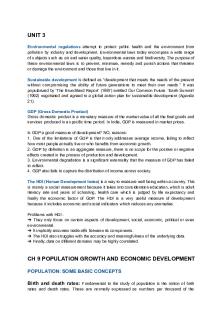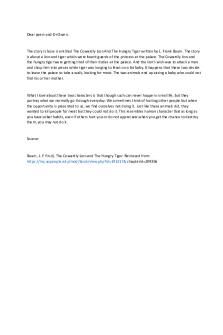ENGL 3355 Unit 3 Summary PDF

| Title | ENGL 3355 Unit 3 Summary |
|---|---|
| Author | Morgan Greenwade |
| Course | POST-COLONIAL LITERATURE IN ENGLISH |
| Institution | The University of Texas at Arlington |
| Pages | 3 |
| File Size | 80.6 KB |
| File Type | |
| Total Downloads | 78 |
| Total Views | 149 |
Summary
Download ENGL 3355 Unit 3 Summary PDF
Description
AN AMERICAN RENAISSANCE? The writers in this volume, particularly those who began publishing after 1830, are often celebrated as part of a literary “renaissance,” and their writings heralded as the first really mature and significant works by Americans. Writers like Ralph Waldo Emerson, Henry David Thoreau, Nathaniel Hawthorne, Herman Melville, and Walt Whitman are seen as central figures in this so-called American Renaissance. Most of these writers were not celebrated this way in their own time but were identified restrospectively, almost a century after their publications, as part of this “renaissance.” More recently, scholars and critics have begun to challenge the idea of an American Renaissance, noting that the formulation has tended to exclude the contributions of women and minority writers of the period, especially African Americans. They also note that studies of the American Renaissance have not paid enough attention to issues such as slavery, immigration, and other political and social contexts that shaped the writing of this period. Nonetheless, the idea of an American Renaissance remains influential and shapes the structure of anthologies such as this one.
AMERICAN LITERARY NATIONALISM While the 1830s through 1850s is usually identified as the period when American literature came into its own, the 1820s were actually the years when critics first agreed that the United States had produced writers who wrote distinctively American works worthy of a great nation. This interest in producing identifiably American works, and celebrating those works, can be called “literary nationalism.” In the wake of the American victory over England in the War of 1812, a new confidence and sense of national identity emerged. Many Americans saw their country as a place of democratic ideals that afforded opportunity to ordinary people rather than rewarding unearned social distinction or inherited wealth. Writers like Washington Irving, William Cullen Bryant, and James Fenimore Cooper achieved international reputations as distinctively American writers. Still, most Americans, and certainly most American writers, regarded their literature as not necessarily distinct from but rather in conversation with English literary traditions. American writers in this period did not write uncritically patriotic texts. Instead, their works reflected and participated in anxieties about the future of a young nation grappling with divisive issues such as slavery, states’ rights, national tariffs, and other matters. Many writers and artists in the 1820s placed a special emphasis on the importance of America’s natural landscape for the development of national character.
THE LITERARY MARKETPLACE IN AN EXPANDING NATION By the 1820s, Americans had easy access to British literature and criticism, which, thanks to lax international copyright laws, could be republished and redistributed in the United States almost immediately after publication in London. Technological developments in printing and the expansion in railroads, canals, and other forms of transportation allowed for fast, extensive, and economical distribution of printed matter. Land acquired through the 1848 Treaty of Guadalupe Hidalgo following the war with Mexico transformed Americans’ sense of the West—and the amount of land available for settlement and exploitation. Travel literature about westward expansion became a popular genre.
Americans became increasingly interested in literature centered on urban life in this period, in large part because of the tremendous growth in the populations of Boston, Philadelphia, and New York resulting from Irish immigration and the influx of rural people to the cities. Newspaper and magazine publishing exploded between 1825 and the 1860s, providing American authors with new forums for their poetry, fiction, essays, travel writing, and political reportage. Writers such as Edgar Allan Poe, Lydia Sigourney, Margaret Fuller, Nathaniel Hawthorne, and Fanny Fern, among many others, were regularly published in periodicals. Women found ways to enter the antebellum literary marketplace, often by publishing in magazines. Their participation in the print public sphere raised questions about how women should balance private, domestic responsibilities with public participation. Writers such as Harriet Beecher Stowe, Lydia Maria Child, and Margaret Fuller, among many others, answered these questions in different ways.
“RENAISSANCE,” REFORM, CONFLICT Many antebellum writers wrestled with the conviction that American literature and culture were not living up to their Revolutionary and democratic promises, and many of these writers incited and participated in various efforts at reform. But during this time, there were also a variety of notions about what constituted reform. Emerson viewed reform as central to his cultural moment and was active in opposing slavery, affirming the value of temperance and supporting women’s suffrage. He is more noted, however, for his founding role in what many literary historians have termed the Transcendentalist movement. Emerson’s Transcendental writings amounted to a call for philosophical and literary reform. Transcendentalism was never really a formalized movement, but its principles certainly inspired the writing of Fuller, Thoreau, and Whitman, among others. It emphasized the creative powers of the individual mind, the regenerative value of nature, the limits of historical associations and traditions, the stultifying effects of established institutions, and the mystical glories of infancy and childhood. Writers such as Hawthorne and Melville were influenced by Transcendentalism when they grappled with the difficulties of making sense of a universe in which meaning derives from individual creative insights rather than received authority. Concerns about the urban poor and working class immigrants also had an important place in antebellum reform efforts, as writers sought to expose readers to the plight of the impoverished in order to prompt philanthropic interventions. The antebellum period saw a push for women’s rights and particularly women’s right to vote. Elizabeth Cady Stanton presented her “Declaration of Sentiments”—based on Jefferson’s “Declaration of Independence”—at the first women’s rights convention in 1848. Many women writers were also active in the temperance movement to outlaw alcohol. Many antebellum writers took as one of their main subjects the paradox that a nation founded on principles of freedom and equality was implicated in ongoing national crimes: the near-genocide of American Indians, the enslavement of black people, and an expansion that ignored other national sovereignties, including Mexico. Native American spokespersons and writers like Black Hawk and William Apess, among others, criticized white Americans’ deceptive treaties, land-grabbing policies, and cruel violations of Native Americans’ human rights. Resistance to slavery and critiques of white racism were among the principal topics of antebellum African American writers like Frederick Douglass, Frances Harper, and William Wells Brown. Some Northern white writers were also active in the push for abolition, perhaps most famously Harriet Beecher Stowe, whose Uncle Tom’s Cabin was the best-selling novel of the period.
Irresolvable differences between the North and South culminated in the Civil War, a bloody conflict that cost the lives of over six hundred thousand Americans before the South surrendered in 1865. After the war, writers struggled to come to grips with the devastation the war had wrought, as well as the racism, political corruption, and materialism that undermined efforts to follow through on the reformist potential of the North’s victory.
THE SMALL AND LARGE WORLD OF AMERICAN WRITERS, 1820–1865 The authors included in this volume of the anthology were often in conversation with one another, and the number of instances of direct and indirect influences, counterinfluences, friendship, and productive disagreements, are stunning. Most of the writers represented in this anthology also ranged beyond the borders of the United States, either through personal travel or publication. All of the writers regarded the literature of the United States as part of a larger world literature. Writers in this anthology were also interested in much more than their contemporary moment. They were influenced by literature from a wide range of time periods, and by literature and culture from around the globe. Many antebellum writers sought not only to uncover, but also to create, American literary traditions. Some did this by looking back to earlier colonial texts and trying to create a sense of continuity with and from them. Many antebellum authors who are today considered “canonical” were not widely recognized in their own time. Melville, Whitman, Thoreau, and Dickinson all found their most enthusiastic readers in the twentieth century. In this way, their work—and the work of many others represented in this volume— engaged as much with the future as with their own time....
Similar Free PDFs

ENGL 3355 Unit 3 Summary
- 3 Pages

COMS 3355 Spring 2020. 3
- 11 Pages

ENGL 255 Unit 3 study guide
- 5 Pages

Unit 3 - Summary
- 3 Pages

ATAR Notes Unit 3 Summary
- 33 Pages

Unit 1 and 3 summary
- 11 Pages

ENGL 0101 - Self Quiz Unit 5
- 3 Pages

ENGL 0101 Self-Quiz Unit 7
- 4 Pages

ENGL 1102 Self-Quiz Unit 5
- 4 Pages

ENGL 0101 - Self Quiz Unit 2
- 2 Pages
Popular Institutions
- Tinajero National High School - Annex
- Politeknik Caltex Riau
- Yokohama City University
- SGT University
- University of Al-Qadisiyah
- Divine Word College of Vigan
- Techniek College Rotterdam
- Universidade de Santiago
- Universiti Teknologi MARA Cawangan Johor Kampus Pasir Gudang
- Poltekkes Kemenkes Yogyakarta
- Baguio City National High School
- Colegio san marcos
- preparatoria uno
- Centro de Bachillerato Tecnológico Industrial y de Servicios No. 107
- Dalian Maritime University
- Quang Trung Secondary School
- Colegio Tecnológico en Informática
- Corporación Regional de Educación Superior
- Grupo CEDVA
- Dar Al Uloom University
- Centro de Estudios Preuniversitarios de la Universidad Nacional de Ingeniería
- 上智大学
- Aakash International School, Nuna Majara
- San Felipe Neri Catholic School
- Kang Chiao International School - New Taipei City
- Misamis Occidental National High School
- Institución Educativa Escuela Normal Juan Ladrilleros
- Kolehiyo ng Pantukan
- Batanes State College
- Instituto Continental
- Sekolah Menengah Kejuruan Kesehatan Kaltara (Tarakan)
- Colegio de La Inmaculada Concepcion - Cebu





